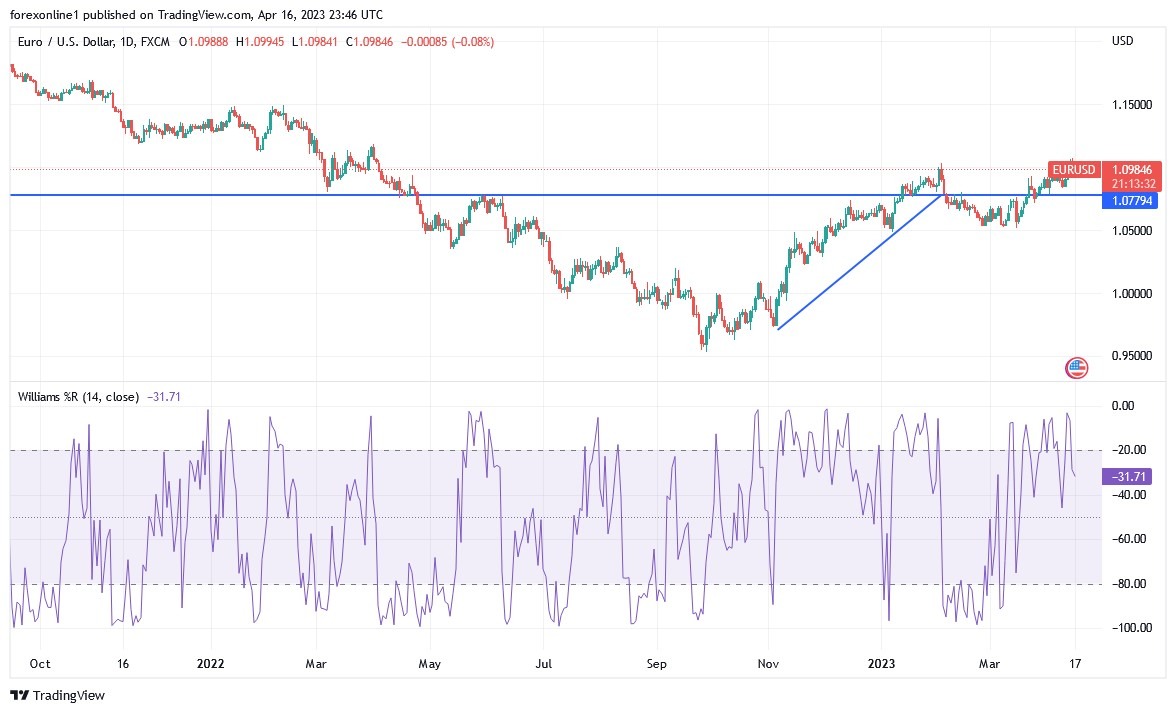The EUR/USD exchange rate got rid of some of its previous gains in the last session of last week's trading, when the decline in US retail sales was followed by comments from Governor Christopher Waller indicating that the US interest rate may rise more in the coming months. EUR/USD's gains extended to the 1.1075 resistance level, the highest for the currency pair in more than a year, and it closed the week's trading stable around 1.0995.
In general, the single European currency was close to the best performing currencies among the major currencies last Friday. It gave ground to the dollar, as the euro against the dollar gave up the psychological resistance 1.10 after the Federal Reserve Governor Waller indicated that the market may be lower than expectations of interest rates. "I interpret this data as indicating that we haven't made significant progress on our inflation target, which leaves me roughly in the same place on the economic outlook that I was at the last FOMC meeting, and on the same path for monetary policy," the official said. At the Graybar National Training Conference in Texas: “Financial conditions have not tightened significantly, the labor market remains very strong and tight, and inflation is well above target, so monetary policy needs to be further tightened.”
According to official figures, inflation in the United States fell by more than expected by many economists in March as a measure of the US Consumer Price Index fell from 6% to 5% when published in the mid-week session, but the more important core inflation rate rose from 5.5%. to 5.6%. The core inflation rate ignores changes in the cost of energy and food as well as regulated price items such as alcohol and tobacco, so it is often seen as a better reflection of the domestically generated inflation pressures that federal policymakers try to manage.
This is why the March increase is likely to be a wrench in the works for those who might have been hoping the Fed rate cycle was over, while the potential for further increases in the Fed Funds rate is a risk for the Euro given the market pricing and interest rate expectations in the United States and Europe.
The Federal Reserve member added, “Another effect from my point of view and the slow progress in recent times is that until now, monetary policy must remain tight for a long period of time, and for a longer period than the markets expect.” "But there is still more than two weeks until the next FOMC meeting, and I am willing to adjust my position based on what we have learned about the economy, including the terms of lending," he added. The governor cited upcoming data covering the housing sector, personal income and other sectors of the economy as important influences on his interest rate decision next month, but warned that without signs of "moderation in demand," borrowing costs are likely to rise further.
FOMC members on average predicted in February that US interest rates were likely to rise to between 5.1% and 5.4% in a sign of two more increases in the fed funds rate still in place for this year. Meanwhile, Governor Waller himself told the Midsize Bank of America Coalition in Los Angeles shortly after the February forecast that he would support raising US interest rates in this way if US employment growth remains strong and if inflation does not resume the downward trajectory seen. previously.
Since then, employment growth has continued to moderate while some parts of the economy have begun shedding jobs, although inflation is most important to the Federal Reserve and Governor Waller at least has not yet had enough of slowing prices. This is to the extent that FOMC members share the same view, financial markets in the coming weeks may have to abandon continued bets on the possibility of the Federal Reserve cutting interest rates before the end of the year and increasing rates.
That could act as a headwind to the recovery in the EUR/USD rate, and if the recent link to the 2-year interest rate differential is anything to go by, it is likely to lead the European single currency to trade near the 1.06 level from the 1.10 resistance that has been set.
Euro predictions against the dollar today:
- The general trend of the EUR/USD currency pair is still bullish.
- Stability around and above the psychological resistance 1.1000 confirms this trend.
- This is taking into account that the continued weakness of the dollar may bring the bulls the momentum to move towards stronger ascending levels.
- The closest levels are 1.1075, 1.1120, and 1.1200, respectively, which is sufficient to push the technical indicators towards strong overbought levels.
Moving towards these peaks requires investors to abandon the dollar, with calming expectations about the future of raising US interest rates, and at the same time continuing the momentum for the euro from the upcoming tightening of the European Central's policy.
On the other hand, and over the same time period, breaking the support levels at 1.0920 and 1.0845, respectively, will be important to start forming the opposite descending channel. I expect a quiet trading session today, amidst the economic calendar's lack of economic data and influencing events.
Ready to trade our Forex daily forecast? We’ve shortlisted the best Forex brokers in the industry for you.


